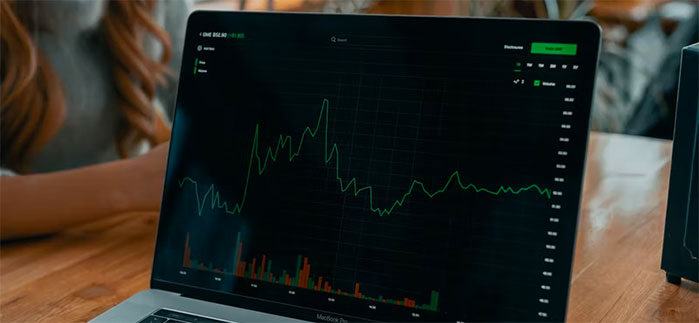All stablecoins are believed to be backed by a real-world asset, such as a national currency or precious metal, which is a good assumption to make. For example, the USD Coin, Tether Gold, and Binance USD are all stablecoins that are backed by other assets, which means the likelihood of them crashing and being lost is much lower than for stablecoins that do not have other assets backing them.
Additionally, this type of cryptocurrency may appeal to investors who would otherwise be wary of investing in regular cryptocurrencies because of their volatility.
In spite of that, there are a number of stablecoins that are not even backed by real assets. As the name suggests, these are algorithmic stablecoins. An algorithmic stablecoin uses a mathematical algorithm to maintain its value over time, just as its name suggests.
According to these algorithms, a pair of coins is linked together, and the price is adjusted based on the supply and demand of this pair of coins. There are algorithm-based stablecoins that are pegged to the value of a real-world asset, but they are not backed by that asset.
What are the Algorithmic Stablecoins?
As their name suggests, they are algorithmic in nature since the mechanism that backs them is an on-chain algorithm. The algorithm facilitates the exchange of supply and demand between the stablecoins and the crypto assets that are supporting them.
There is no doubt that the word algorithm is a confusing one. Essentially, it simply refers to a set of instructions that instruct a process to follow. Hence, for example, Facebook’s timeline algorithms decide what you see on your timeline based on your past online behavior, such as how relevant the post is to you based on what you have done in the past on the site. Cryptography refers to pieces of code that can be found on a blockchain in the form of smart contracts, so an algorithm refers to a set of codes on a blockchain.
The algorithm (or the smart contact) that is responsible for the relationship between the two tokens is typically responsible for implementing the algorithm (or the smart contact) that regulates the relationship between the two tokens.
In order to find the best algorithmic stablecoin that is suitable for you, there are three main types that you can choose from: rebased, seigniorage, and fractional-algorithmic. There are several different types of algorithms used to maintain the value of each of these coin types.
The supply of a stablecoin can be controlled by rebasing algorithmic stablecoins in order to maintain their value. There are a number of examples of algorithmic stablecoins that are rebased, such as Ampleforth.
In order to maintain the value of the other coins, a multi-coin structure is used for Seigniorage algorithmic stablecoins, in which one coin is minted or burned to maintain the value of another coin. A good example of this would be Terra Lab’s Luna and UST crypto coins.
Stablecoins that are backed by fractional-algorithm algorithms are largely collateralized, which means they are partially backed by real-world assets in some way. A fractional algorithmic stablecoin is one that is partially backed by a USD Coin – the stablecoin that is backed by the United States dollar. This is an example of a fractional algorithmic stablecoin.
What Risks Have Algorithmic Stablecoins?
Since algorithmic stablecoins do not actually have any real-world backing, they pose quite a significant risk as they are not backed by any real-world assets. As a result, they are not strictly stablecoins either. As they do not have any collateral, their prices are not as stable as you would like to think, so it is not as safe as you would like to think that their prices would be.
To maintain value, algorithmic stablecoins need a steady stream of demand, just as it is with many other cryptocurrencies. It is well known that the demand for a coin in the crypto industry can change dramatically from one day to the next due to a wide variety of factors, and this on its own is still a huge weakness for algorithmic stablecoins due to this fact.
Additionally, depending on the type of algorithmic stablecoin in question, there can be a knock-on effect caused by the crash in the value of one coin in a pair of algorithmic stablecoins. As we saw in the case of the LUNA//UST disaster, this is exactly what happened. So, in summary, if things go wrong with an algorithmic stablecoin, then it can spell double trouble for the user.
How do they maintain their parity with the dollar?
Despite the fact that stablecoin prices are subject to market fluctuations, algorithms are used to ensure that they do not depeg – move away from $1 – due to market conditions. An asset’s price rises when there’s a surplus of demand for it, but a dearth of supply, which can be seen when there are too many people seeking that asset – or vice versa.
We will explore the algorithm’s promise to keep UST in check in the following section, and we’ll then delve further into how that can go terribly wrong as we look at the algorithm’s promise in the context of UST.
There are a few different ways UST may be used to maintain its 1:1 parity with the U.S. dollar. For example, TerraUSD maintains its 1:1 parity with the U.S. dollar through an algorithmic relationship with Terra’s native cryptocurrency, LUNA. As the UST peg moves in either direction or in the other direction, there is always an arbitrage opportunity arising from this relationship.
The price of UST can rise above $1 if the supply of UST is too small or if the demand for UST is too high. UST is currently pegged to the USD at a rate of 1 USD of LUNA for 1 UST within the Terra protocol to bring it back to its peg. In the process, 1 USD of LUNA is burnt, and 1 UST is produced.
Stablecoins Vs. Algorithmic Stablecoins
Most stablecoins are pegged to a currency according to a 1:1 ratio using a mechanism of collateral to ensure that the stablecoin’s value is pegged to the currency it tracks. It is a digital currency in which the value of the stablecoin is supported by a digital asset which, in turn, is backed up by cash or another asset whose value contributes to the sustainability of the stablecoin’s value.
A number of stablecoins exist that are collateralized with assets that are not tied to the blockchain. For example, cash and cash-equivalent bonds that are held in a centralized bank or another organization with management control over them are actually collateralized with off-chain assets, including Tether (USDT).
A number of differences exist between algorithmic stablecoins and traditional stablecoins that need to be taken into consideration. The majority of these cryptocurrencies do not have any collateral backing behind them, and instead, they rely on sophisticated algorithms to maintain their peg with the fiat currency they are tracking. Furthermore, these algorithms are also capable of incentivizing investors and manipulating their behavior in order to stabilize the price of the coin around the peg.
The Most Known Algorithmic Stablecoins
In the current market, there are a number of stablecoins, each of which has its own specific features and advantages. It is important to understand that they differ based on the tokens used for governance and the collateralization algorithm.
FRAX
Frax Protocol is a stablecoin platform that uses ad hoc algorithms to produce stablecoins. A part of Frax is being implemented on Ethereum, which is an open-source project that is permissionless, on-chain, and open source. There is no fixed supply of digital assets like Bitcoin or Ethereum, which is why Frax is designed to provide highly scalable, decentralized, algorithmic money as an alternative to those.
Neutrino USD
A stablecoin pegged to the U.S. dollar is called Neutrino USD, which reflects an algorithmic crypto-collateralization process. A smart contract governs all operations, including the issuance, collateralization, staking, reward distribution, and reward payouts of USDN, including the issuance, collateralization, staking, and reward payouts.
USDD
In summary, USDD is a cryptocurrency that is issued by the TRON DAO Reserve, and that has a stable price as well as a wide range of uses. USDD is designed to provide a self-stabilizing mechanism against price fluctuations and is accompanied by a responsive monetary policy that will enable USDD to become a true settlement currency and keep its value as it goes through price fluctuations.
Celo Dollar
With Celo, you get access to a global payments network that develops innovative financial tools you can use from any mobile device you own. This cryptocurrency was created by Celo, and it has been pegged to the U.S. Dollar so that it can be used as a stablecoin. In addition to making financial solutions such as transfers and accepting payments easier and cheaper, this stablecoin is making the process of making financial solutions more efficient.
Celo has built its Protocol in such a way that, in order to maintain stability, which is at the core of the concept of a stablecoin, it guides its reserves to align with the supply of Celo Dollars so as to match market demand and maintain the currency’s peg to U.S. Dollars at the same time. Celo uses its reserves to buy more cUSD in the open market if the value of one cUSD declines below a dollar, which then reduces the supply and keeps the peg to a dollar by selling CELO from the reserves. A peg is maintained by minting new cUSD to maintain its value when the value of cUSD surpasses a dollar and selling them for CELO, thus maintaining the peg at a given value.
TerraClasicUSD
The UST depeg led to Do Kwon’s proposal for the revival of Terra’s blockchain. This proposal involved splitting the Terra blockchain into a new chain named Terra 2.0. During this process, Terra Classic would continue to exist as the older Terra chain. The community voted in favor of the revival plan, and most of the DeFi DApps have since migrated to the new Terra 2.0 chain as a result.
TerraClassicUSD (USTC) is the new name for UST, and it only trades on the old Terra Classic blockchain, now called TerraClassicUSD (USTC). It has been confirmed by Do Kwon that USTC will not be migrated to Terra 2.0, as well as there will be no updated version of the algorithmic stablecoin. Therefore, TerraClassicUSD is considered to be a defunct stablecoin, and there is no expectation that it will regain its pegged currency in the near future.
Fei USD
It was developed by Fei Labs Inc., a company specializing in the production of stablecoins, to create the Fei protocol. With the help of various innovations, the project aims to improve the concept of stablecoins by implementing a number of improvements. To ensure that Uniswap’s liquidity pool and FEI, its native stablecoin, remain close to the USD exchange rate, it uses a mechanism called Protocol Controlled Value (PCV) as well as a variety of other tools to monitor the USD exchange rate. There is also a native governance token called TRIBE, which is introduced as part of the project.
Conclusion
Although algorithmic stablecoins sound like an exciting concept, in theory, they have a long way to go before they are considered stable stores of value by the public. In some cases, algorithmic stablecoins have achieved a stable peg, but there hasn’t yet been a successful algorithmic stablecoin to date. Therefore, their use cases tend to be geared towards traders who are looking to engage in speculative arbitrage.
As well as this, algorithmic stablecoins have the potential to create an environment for innovation at the same time. In particular, they are a platform for pushing the boundaries of what is technically possible in DeFi, attracting a group of brilliant and eclectic thinkers and builders who are innovating and iterating the existing models in terms of technology.




















